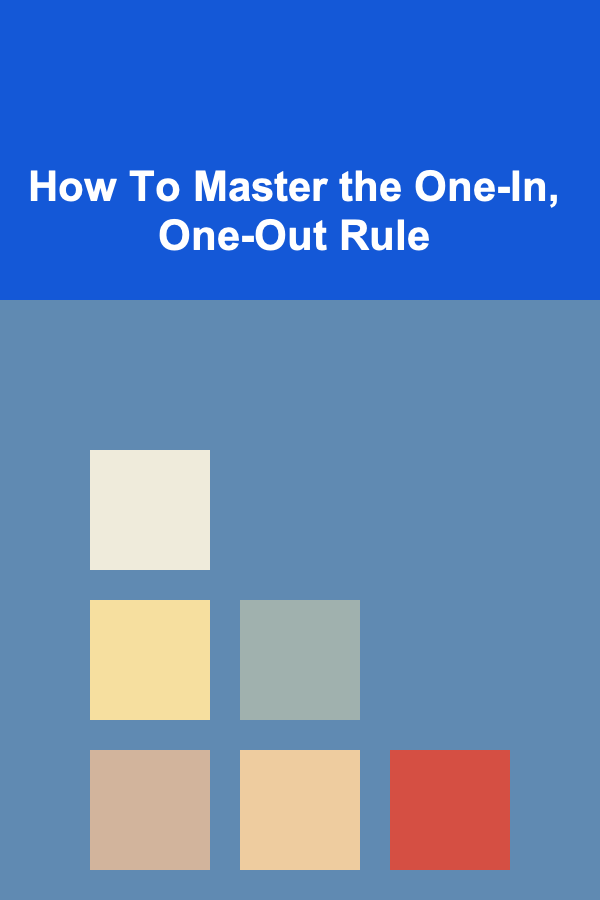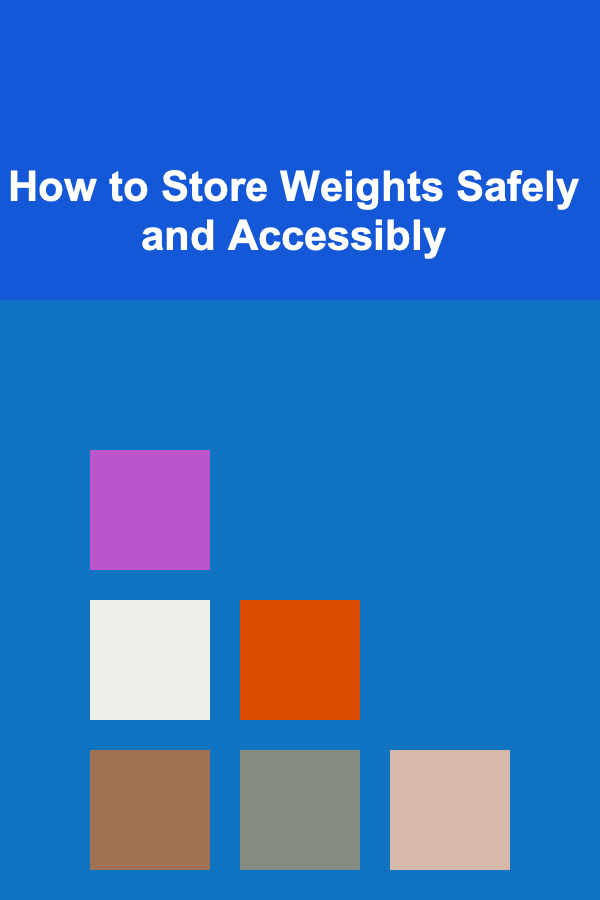
How To Master the One-In, One-Out Rule
ebook include PDF & Audio bundle (Micro Guide)
$12.99$8.99
Limited Time Offer! Order within the next:

The "One-In, One-Out" rule is a minimalist principle that encourages individuals to remove one item from their life each time they acquire something new. This rule is particularly helpful in combating the culture of overconsumption and clutter that many people struggle with. In a world where consumerism often leads to the accumulation of possessions, adopting a "One-In, One-Out" mindset can provide both physical and mental benefits by promoting a more intentional and mindful approach to consumption.
In this article, we will explore how to master the One-In, One-Out rule. We'll dive into its origins, why it works, the psychological benefits, and practical strategies to apply it to various aspects of life. By the end of this article, you will understand not only how to implement the rule but also why it's worth committing to in the long term.
The Origins and Concept of the One-In, One-Out Rule
The "One-In, One-Out" rule has its roots in the minimalist movement, which advocates for a lifestyle focused on reducing excess in order to prioritize what truly matters. The essence of this principle is simple: each time you acquire something new, you must remove an equivalent item from your possession. This could apply to anything, from clothes to electronics, books, or even habits. The goal is to prevent unnecessary clutter from accumulating, both in your physical space and in your life.
The rule can be traced back to the philosophy of minimalism, which began gaining traction in the early 21st century. Minimalists emphasize living with fewer material possessions to create space for more meaningful experiences, relationships, and personal growth. In this context, the One-In, One-Out rule serves as a tool for curbing overconsumption and fostering a more sustainable and mindful lifestyle.
Why the One-In, One-Out Rule Works
1. Encourages Mindful Consumption
One of the primary reasons the One-In, One-Out rule is so effective is because it encourages mindful consumption. Every time you acquire something new, the rule forces you to pause and reflect on your need for that item. It challenges impulse buying and encourages intentional decisions about what truly adds value to your life.
For example, if you're tempted to buy a new pair of shoes, you might consider whether you really need them or if your existing collection is sufficient. This reflection helps curb unnecessary purchases and promotes more thoughtful decision-making.
2. Reduces Clutter
Clutter is not just a physical issue---it can also contribute to mental and emotional stress. A disorganized environment can overwhelm the mind and reduce your ability to focus. The One-In, One-Out rule combats clutter by ensuring that new possessions are balanced by removing older, unused, or unnecessary items.
This creates a more organized, serene space that can improve your quality of life. When your surroundings are clean and uncluttered, it's easier to feel relaxed and focused, both at home and in your workplace.
3. Prevents Overconsumption
In today's consumer-driven society, it's easy to accumulate far more than we need. Advertisements, social media, and the constant availability of new products often push people to buy items that don't align with their values or needs. The One-In, One-Out rule serves as a natural check on overconsumption, ensuring that your possessions are more in line with what you truly need and want.
By regularly purging unnecessary items, you also make room for more purposeful purchases in the future. The rule helps break the cycle of consumerism that can lead to debt, stress, and a sense of emptiness.
4. Promotes Sustainable Living
Adopting the One-In, One-Out rule can also have a positive impact on the environment. Overconsumption and the disposal of products contribute to environmental degradation. By reducing the number of things you own, you decrease waste and encourage a more sustainable lifestyle. This principle aligns with the broader movement of sustainability, which aims to minimize the impact of human activity on the planet.
For instance, by keeping the number of clothes or gadgets you own in check, you contribute to reducing the demand for fast fashion and electronic waste. The rule encourages a more mindful approach to buying items that are durable and long-lasting.
Practical Steps to Master the One-In, One-Out Rule
Now that we understand the underlying philosophy and benefits of the One-In, One-Out rule, let's explore practical steps for implementing it in various areas of life.
1. Start Small with One Area of Your Life
If you feel overwhelmed by the idea of applying the rule to every aspect of your life, start small. Pick one area---such as your wardrobe, your bookshelf, or your kitchen---and apply the One-In, One-Out rule there first. Once you get comfortable with the process, you can gradually expand the rule to other areas.
For example, if you're tackling your wardrobe, every time you buy a new clothing item, choose an old one that no longer fits, is outdated, or you simply no longer wear, and donate or sell it. This approach keeps things manageable and allows you to experience the benefits without feeling overwhelmed.
2. Set Guidelines for What Qualifies as a "One-In"
To successfully apply the One-In, One-Out rule, you need to establish some guidelines for what constitutes a "One-In." Not every new item you acquire will require you to remove something from your life. For instance, if you're replacing an item that is broken or worn out (like a pair of shoes), you might not need to remove an additional item. Similarly, if you acquire something essential---such as a necessary replacement item or something you've been planning for---you may adjust the rule accordingly.
On the other hand, if you're making a frivolous purchase, it's important to stick to the rule more strictly. Establishing a clear distinction between what counts as a necessary purchase versus a discretionary one will help you maintain the effectiveness of the rule.
3. Set a Goal and Keep Track
Setting goals and tracking your progress can help you stay motivated as you master the One-In, One-Out rule. For instance, you might aim to declutter a specific area of your home within a certain timeframe, or you might decide to minimize the number of books, clothes, or electronics you own by a certain percentage.
Keeping a record of how many items you've removed and replaced can serve as a visual reminder of your progress. It also allows you to appreciate the space and freedom that decluttering can bring. There are many apps and tools available that can help you keep track of your possessions and help you stay accountable.
4. Embrace the Emotional Benefits
Mastering the One-In, One-Out rule isn't just about getting rid of physical clutter; it's about creating space for emotional and mental clarity as well. As you remove items that no longer serve you, you might also experience a sense of freedom or release. It's not just about less stuff---it's about having more room for the things that matter most, such as meaningful experiences, relationships, and personal growth.
Take the time to reflect on how your relationship with material possessions has changed as you implement this rule. Notice how it impacts your emotional state, your environment, and even your relationships. The more you embrace the emotional benefits of the rule, the easier it will be to continue practicing it long term.
5. Involve Family or Friends
If you live with family members or roommates, involve them in the process. The One-In, One-Out rule is most effective when everyone in the household adopts it. Have discussions with your family about the benefits of reducing clutter and overconsumption. You could even challenge each other to see who can reduce the most unnecessary items from their lives.
This shared effort can help build a supportive environment where everyone works together toward the common goal of creating a more minimalist and mindful lifestyle.
6. Donate or Sell Unwanted Items
When you remove items as part of the One-In, One-Out rule, don't just throw them away. Instead, consider donating or selling them. This is a great way to give the items a second life and reduce your environmental footprint. Donation centers and second-hand stores often accept gently used clothes, books, and other items, while selling unwanted items can help you earn extra money.
This process also reinforces the idea that possessions should have value, and it encourages you to think more intentionally about what you bring into your home in the future.
7. Be Flexible and Adjust the Rule
While the One-In, One-Out rule is a great tool for managing possessions, it's important to remember that life is not always predictable. There may be situations where acquiring something new is necessary or unavoidable. In these cases, it's okay to be flexible with the rule. For example, if you receive a gift or acquire something that enhances your well-being, it's acceptable to bend the rule slightly.
However, the key is to maintain a sense of balance. If you let one new acquisition slide without removing an item, be mindful of this and make a conscious effort to ensure that it doesn't become a pattern. Flexibility should not undermine the overall goal of reducing clutter and promoting mindful consumption.
Conclusion
Mastering the One-In, One-Out rule is about more than just reducing the number of things you own---it's about creating a life that is more intentional, organized, and focused on what truly matters. By embracing mindful consumption, reducing clutter, and cultivating a more sustainable lifestyle, you can experience the physical, mental, and emotional benefits of minimalist living.
While it may take time and effort to adjust to this rule, the rewards are significant. You will not only enjoy a more organized living space, but you will also experience greater freedom and clarity in your daily life. So, start small, stay committed, and embrace the power of simplicity. Your future self will thank you.

How to Sell Homemade Products Online and Earn Extra Income
Read More
How to Stage a Vacant Home to Help Buyers Visualize Its Potential
Read More
How to Store Weights Safely and Accessibly
Read More
How to Use a Shredder to Protect Your Privacy
Read More
How to Minimize Breakouts Around the Jawline
Read More
10 Tips for Maintaining Your Financial Planning Checklist
Read MoreOther Products

How to Sell Homemade Products Online and Earn Extra Income
Read More
How to Stage a Vacant Home to Help Buyers Visualize Its Potential
Read More
How to Store Weights Safely and Accessibly
Read More
How to Use a Shredder to Protect Your Privacy
Read More
How to Minimize Breakouts Around the Jawline
Read More